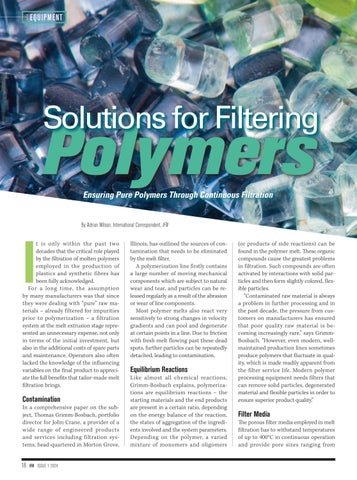EQUIPMENT
Solutions for Filtering
Polymers Ensuring Pure Polymers Through Continuous Filtration
By Adrian Wilson, International Correspondent, IFN
I
t is only within the past two decades that the critical role played by the filtration of molten polymers employed in the production of plastics and synthetic fibres has been fully acknowledged. For a long time, the assumption by many manufacturers was that since they were dealing with “pure” raw materials – already filtered for impurities prior to polymerization – a filtration system at the melt extrusion stage represented an unnecessary expense, not only in terms of the initial investment, but also in the additional costs of spare parts and maintenance. Operators also often lacked the knowledge of the influencing variables on the final product to appreciate the full benefits that tailor-made melt filtration brings.
Contamination In a comprehensive paper on the subject, Thomas Grimm-Bosbach, portfolio director for John Crane, a provider of a wide range of engineered products and services including filtration systems, head-quartered in Morton Grove,
18 IFN ISSUE 1 2024
Illinois, has outlined the sources of contamination that needs to be eliminated by the melt filter. A polymerization line firstly contains a large number of moving mechanical components which are subject to natural wear and tear, and particles can be released regularly as a result of the abrasion or wear of line components. Most polymer melts also react very sensitively to strong changes in velocity gradients and can pool and degenerate at certain points in a line. Due to friction with fresh melt flowing past these dead spots, further particles can be repeatedly detached, leading to contamination.
Equilibrium Reactions Like almost all chemical reactions, Grimm-Bosbach explains, polymerizations are equilibrium reactions – the starting materials and the end products are present in a certain ratio, depending on the energy balance of the reaction, the states of aggregation of the ingredients involved and the system parameters. Depending on the polymer, a varied mixture of monomers and oligomers
(or products of side reactions) can be found in the polymer melt. These organic compounds cause the greatest problems in filtration. Such compounds are often activated by interactions with solid particles and then form slightly colored, flexible particles. “Contaminated raw material is always a problem in further processing and in the past decade, the pressure from customers on manufacturers has ensured that poor quality raw material is becoming increasingly rare,” says GrimmBosbach. “However, even modern, wellmaintained production lines sometimes produce polymers that fluctuate in quality, which is made readily apparent from the filter service life. Modern polymer processing equipment needs filters that can remove solid particles, degenerated material and flexible particles in order to ensure superior product quality.”
Filter Media The porous filter media employed in melt filtration has to withstand temperatures of up to 400°C in continuous operation and provide pore sizes ranging from















